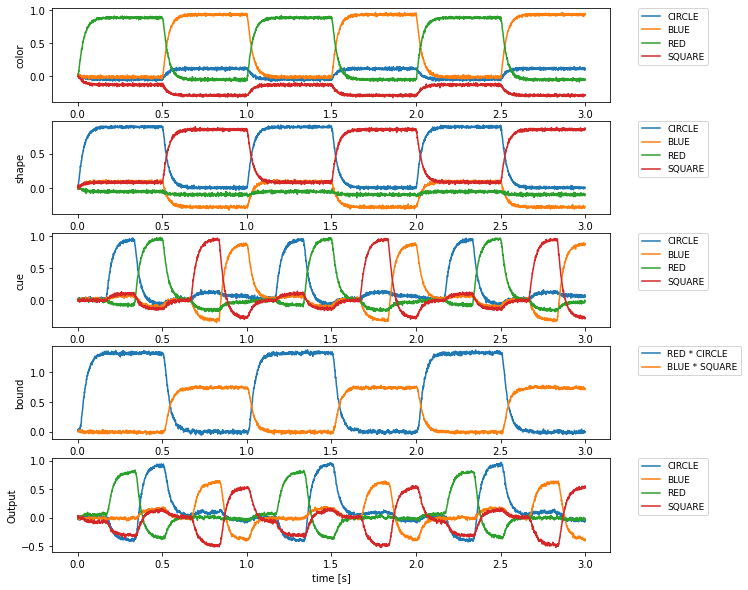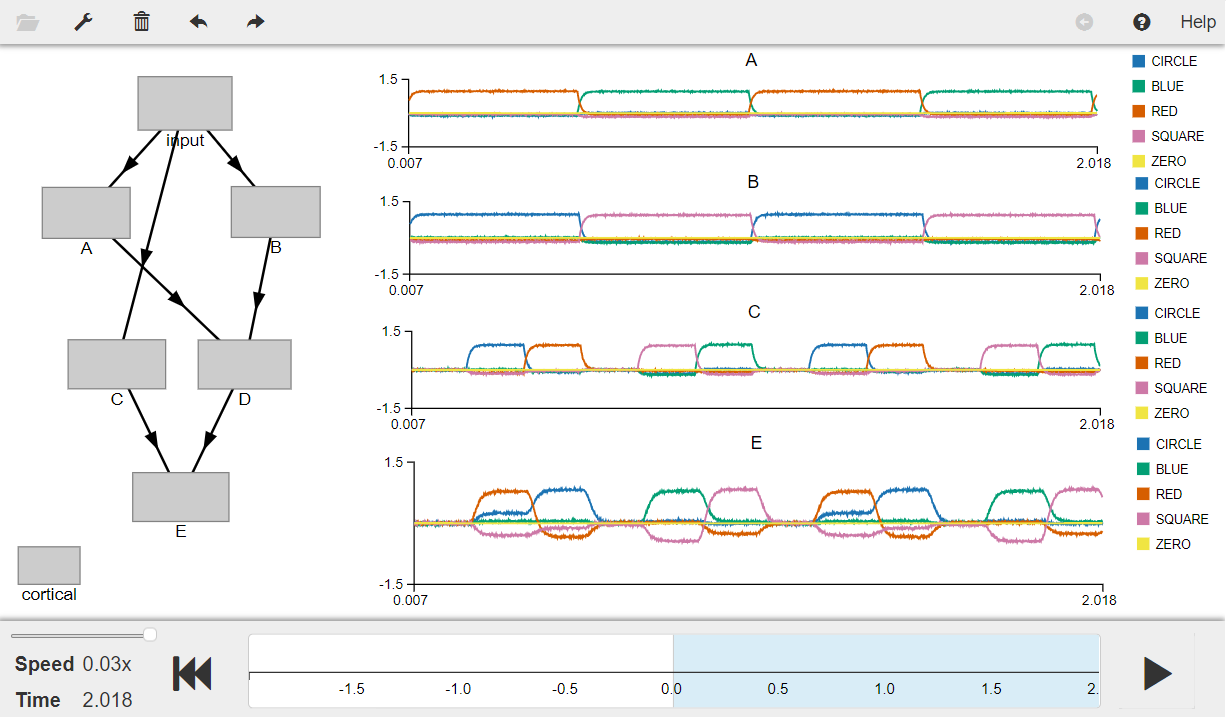- NengoLoihi
- How to Build a Brain
- Tutorials
- A Single Neuron Model
- Representing a scalar
- Representing a Vector
- Addition
- Arbitrary Linear Transformation
- Nonlinear Transformations
- Structured Representations
- Question Answering
- Question Answering with Control
- Question Answering with Memory
- Learning a communication channel
- Sequencing
- Routed Sequencing
- Routed Sequencing with Cleanup Memory
- Routed Sequencing with Cleanup all Memory
- 2D Decision Integrator
- Requirements
- License
- Tutorials
- NengoCore
- Ablating neurons
- Deep learning
Question Answering¶
This model shows a simple form of question answering. The goal of this model is to build a network that will output answers to questions based on supplied statements as described in the book. You will bind two features (color and shape) by circular convolution. Then you will provide a cue to the model to determine either one of the features by deconvolution.
Note: Simplified method of building the model using the SPA (semantic pointer architecture) package in Nengo 2.0 is shown in the last few sections of this notebook.
[1]:
# Setup the environment
import matplotlib.pyplot as plt
import numpy as np
%matplotlib inline
import nengo
from nengo.spa import Vocabulary
Create the model¶
This model has parameters as described in the book, with the ensembles having 300 neurons in 20 dimensions and the bind and unbind networks having 70 neurons per dimension. The model relies on SPA (Semantic Pointer Architecture) methods for charachterizing representation, transformation and control.
Depending on your computer, this model may run slowly which can be avoided by several ways as discussed in the book. In order to run the model in direct mode (explained in the book), the parameter ‘neuron_type’ should be set to nengo.Direct() while creating the ensembles.
As mentioned in the book, the color input will alternate every 0.5 seconds between RED and BLUE. In the same way the shape input alternates between CIRCLE and SQUARE. Thus, the model will bind alternatingly RED * CIRCLE and BLUE * SQUARE for 0.5 seconds each. In parallel you will ask a question from the model by providing a cue which will be used for deconvolving bound semantic pointers to determine an answer. For example, when the cue is CIRCLE the model should respond with RED. The cue will cycle through CIRCLE, RED, SQUARE, and BLUE within one second.
[2]:
dim = 20 # Number of dimensions
n_neurons = 300 # Number of neurons in population
n_conv = 70 # Number of neurons per dimension in bind/unbind populations
rng = np.random.RandomState(0)
vocab = Vocabulary(dimensions=dim, rng=rng, max_similarity=0.1)
model = nengo.Network(label="Question Answering", seed=7)
with model:
# Ensembles
ens_A = nengo.Ensemble(n_neurons=n_neurons, dimensions=dim, label="A")
ens_B = nengo.Ensemble(n_neurons=n_neurons, dimensions=dim, label="B")
ens_C = nengo.Ensemble(n_neurons=n_neurons, dimensions=dim, label="C")
ens_D = nengo.Ensemble(n_neurons=n_neurons, dimensions=dim, label="D")
ens_E = nengo.Ensemble(n_neurons=n_neurons, dimensions=dim, label="E")
# Creating the bind network
net_bind = nengo.networks.CircularConvolution(n_neurons=n_conv, dimensions=dim)
nengo.Connection(ens_A, net_bind.A)
nengo.Connection(ens_B, net_bind.B)
nengo.Connection(net_bind.output, ens_D)
# Creating the Unbind network
net_unbind = nengo.networks.CircularConvolution(
n_neurons=n_conv, dimensions=dim, invert_a=True
)
nengo.Connection(ens_C, net_unbind.A)
nengo.Connection(ens_D, net_unbind.B)
nengo.Connection(net_unbind.output, ens_E)
# Getting semantic pointer values
CIRCLE = vocab.parse("CIRCLE").v
BLUE = vocab.parse("BLUE").v
RED = vocab.parse("RED").v
SQUARE = vocab.parse("SQUARE").v
ZERO = [0] * dim
# Function for providing color input
def color_input(t):
if (t // 0.5) % 2 == 0:
return RED
return BLUE
# Function for providing shape input
def shape_input(t):
if (t // 0.5) % 2 == 0:
return CIRCLE
return SQUARE
# Function for providing the cue
def cue_input(t):
sequence = [ZERO, CIRCLE, RED, ZERO, SQUARE, BLUE]
idx = int((t // (1.0 / len(sequence))) % len(sequence))
return sequence[idx]
# Defining inputs
input_A = nengo.Node(output=color_input, size_out=dim, label="Input A")
input_B = nengo.Node(output=shape_input, size_out=dim, label="Input B")
input_C = nengo.Node(output=cue_input, size_out=dim, label="Input C")
# Connecting input to ensembles
nengo.Connection(input_A, ens_A)
nengo.Connection(input_B, ens_B)
nengo.Connection(input_C, ens_C)
Add Probes to Collect Data¶
Anything that is probed will collect the data it produces over time, allowing you to analyze and visualize it later.
[3]:
with model:
A_probe = nengo.Probe(ens_A, synapse=0.03)
B_probe = nengo.Probe(ens_B, synapse=0.03)
C_probe = nengo.Probe(ens_C, synapse=0.03)
D_probe = nengo.Probe(ens_D, synapse=0.03)
E_probe = nengo.Probe(ens_E, synapse=0.03)
Run the model¶
In order to run the model without nengo_gui, you have to create a Nengo simulator. Then, you can run that simulator over and over again without affecting the original model.
[4]:
with nengo.Simulator(model) as sim: # Create the simulator
sim.run(3.0) # Run it for 3 seconds
Plot the results¶
[5]:
plt.figure(figsize=(10, 10))
plt.subplot(5, 1, 1)
plt.plot(sim.trange(), nengo.spa.similarity(sim.data[A_probe], vocab))
plt.legend(vocab.keys, bbox_to_anchor=(1.05, 1), loc=2, borderaxespad=0.0, fontsize=9)
plt.ylabel("color")
plt.subplot(5, 1, 2)
plt.plot(sim.trange(), nengo.spa.similarity(sim.data[B_probe], vocab))
plt.legend(vocab.keys, bbox_to_anchor=(1.05, 1), loc=2, borderaxespad=0.0, fontsize=9)
plt.ylabel("shape")
plt.subplot(5, 1, 3)
plt.plot(sim.trange(), nengo.spa.similarity(sim.data[C_probe], vocab))
plt.legend(vocab.keys, bbox_to_anchor=(1.05, 1), loc=2, borderaxespad=0.0, fontsize=9)
plt.ylabel("cue")
plt.subplot(5, 1, 4)
for pointer in ["RED * CIRCLE", "BLUE * SQUARE"]:
plt.plot(sim.trange(), vocab.parse(pointer).dot(sim.data[D_probe].T), label=pointer)
plt.legend(bbox_to_anchor=(1.05, 1), loc=2, borderaxespad=0.0, fontsize=9)
plt.ylabel("bound")
plt.subplot(5, 1, 5)
plt.plot(sim.trange(), nengo.spa.similarity(sim.data[E_probe], vocab))
plt.legend(vocab.keys, bbox_to_anchor=(1.05, 1), loc=2, borderaxespad=0.0, fontsize=9)
plt.ylabel("Output")
plt.xlabel("time [s]")
[5]:
Text(0.5, 0, 'time [s]')

The last graph shows that the output is most similar to the semantic pointer bound to the current cue. For example, when RED and CIRCLE are being bound and the cue is CIRCLE, the output is most similar to RED.
Create the model using the nengo.spa package¶
Now we will build this model again, using the nengo.spa package built into Nengo 2.0. You will see that using the SPA package considerably simplifies model construction and visualization through nengo_gui.
[6]:
from nengo import spa
dim = 32 # The dimensionality of the vectors
rng = np.random.RandomState(4)
vocab = Vocabulary(dimensions=dim, rng=rng, max_similarity=0.1)
# Adding semantic pointers to the vocabulary
CIRCLE = vocab.parse("CIRCLE")
BLUE = vocab.parse("BLUE")
RED = vocab.parse("RED")
SQUARE = vocab.parse("SQUARE")
ZERO = vocab.add("ZERO", [0] * dim)
# Create the spa.SPA network to which we can add SPA objects
model = spa.SPA(label="Question Answering", vocabs=[vocab])
with model:
model.A = spa.State(dim)
model.B = spa.State(dim)
model.C = spa.State(dim)
model.D = spa.State(dim)
model.E = spa.State(dim)
actions = spa.Actions(
"D = A * B",
"E = D * ~C",
)
model.cortical = spa.Cortical(actions)
# Function for providing color input
def color_input(t):
if (t // 0.5) % 2 == 0:
return "RED"
return "BLUE"
# Function for providing shape input
def shape_input(t):
if (t // 0.5) % 2 == 0:
return "CIRCLE"
return "SQUARE"
# Function for providing the cue
def cue_input(t):
sequence = ["ZERO", "CIRCLE", "RED", "ZERO", "SQUARE", "BLUE"]
idx = int((t // (1.0 / len(sequence))) % len(sequence))
return sequence[idx]
# Inputs
model.input = spa.Input(A=color_input, B=shape_input, C=cue_input)
Run the model in nengo_gui¶
[ ]:
from nengo_gui.ipython import IPythonViz
IPythonViz(model, "ch5-question.py.cfg")
Press the play button in the visualizer to run the simulation. You should see the graphs as shown in the figure below.
Graphs A, B, C show the colour, shape and cue inputs respectively. Graph E shows that the output is most similar to the semantic pointer bound to the current cue (showin in C). For example, when RED and CIRCLE are being bound and the cue is CIRCLE, the output is most similar to RED.
[7]:
from IPython.display import Image
Image(filename="ch5-question.png")
[7]:
